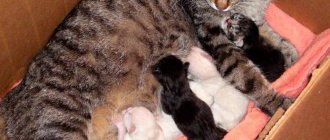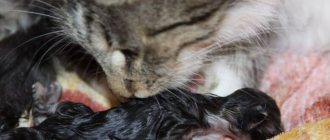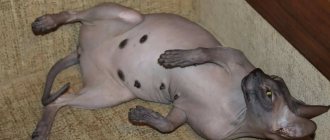Quite an exciting event for a breeder - everyone needs to know how a cat is about to give birth and how to take care of it and how to care for a pet after lambing. During labor, various problems may arise; you need to be prepared for this. In what cases can you handle it yourself, and when you need the help of a veterinarian, read on.
Pregnant cat
How to prepare for a cat giving birth
You need to prepare for lambing in advance, before the cat herself has set up a nest somewhere in the closet or under the bed. If this happens, it will be inconvenient to care for a mother with children. About 2-3 weeks before the expected date of birth, you need to arrange a cozy place where the babies will be born.
You can use various objects as a nest. The main thing is that the whole cat family can stay there. Let's consider several options:
- a spacious cardboard box or box with several ventilation holes;
- a special birth box, which is sold in pet stores;
- a small children's play tent in the form of a house or cube.
Requirements for the nesting area - free access from above, the presence of an entrance for the cat. It should be located at a height of 10 cm from the floor so that the kittens cannot go outside on their own. You need to put oilcloth inside, and a clean old sheet or unnecessary rags on top.
Attention! You cannot use newspapers, cotton wool, or fabrics with frayed edges as bedding - kittens can get tangled in the threads and suffocate.
The box is placed in a dark place in the apartment, protected from drafts. It is advisable to place it where household members are least likely to visit. The room should be warm, but not stuffy.
Show the expectant mother a ready-made nest for lambing, let her sniff everything and lie there. If you notice that closer to the birth the cat is trying to arrange another place, it is better to move the box there.
What not to do at the end of pregnancy
A cat requires special treatment during pregnancy, and especially in the period just before giving birth.
Do you trust doctors and their prescriptions?
Yes
17.83%
No
13.64%
I trust, but I check all medications for reviews on the Internet from people who have already tried them and only then do I start taking them.
51.75%
Yes, but only to appointments and doctors from paid clinics.
16.78%
Voted: 286
What not to do:
- make your pet nervous. Loud noises, shouting, noisy parties and numerous guests are all serious stress for the cat’s body;
- attempt to palpate the abdomen in order to determine the presence or quantity of offspring. A person without experience can cause injury to both the cat and the kittens in the womb.
- independently administer any medications without consulting a veterinarian. All preventive measures must be carried out before a potential pregnancy - flea and tick treatment, vaccination, treatment of chronic diseases, medical examination. If Murka, while pregnant, fell ill, then any appointment should be made only by a specialist;
- ignore any unusual abnormalities in behavior or health: bleeding, vomiting or diarrhea, sudden loss of appetite;
- Allowing a cat to climb and sleep at a height, jumping from a height - the risk of not only bone injuries, but also harm to the offspring;
- allow pregnant Murka to come into contact with strangers or stray animals;
- ignore the rules of hygiene for keeping an animal: you cannot pick up a cat with dirty hands, allow it to sleep in the owners’ outdoor shoes, regularly brush out and change the bedding in a pregnant woman’s sleeping place;
- use aggressive solutions of household chemicals for cleaning the house, which can poison the cat or harm future offspring;
- transfer the woman in labor to another place if the process does not begin where it should be. It is better to bring bedding, and then after giving birth, move it to a secluded place with the kittens.
Signs of approaching and onset of labor
The duration of pregnancy in cats is 57–70 days. At about 7–9 weeks, you can already see the kittens moving when the pet is resting. The upcoming onset of labor can be judged by the behavior of the animal. Signs that lambing is approaching are:
- anxiety, restlessness, the expectant mother may avoid communicating with people or require more attention;
- the cat pulls out hair in the area of the mammary glands;
- loss of appetite;
- frequent urination;
- redness of the external genitalia (observed 1–2 days before birth);
- discharge of colostrum from the nipples;
- discharge of the mucus plug;
- a few hours before the onset of labor, anxiety intensifies, the cat goes to the nest;
- body temperature drops to 37 degrees;
- the animal takes a characteristic pose - arches its back, as if hunched over;
- shortly before birth, the animal's nose and ears become hot.
The cat's mucus plug came off
Soon contractions begin. The stomach periodically tenses and then relaxes. Then the amniotic fluid usually leaves. As a rule, the first kitten emerges from the reproductive tract within 1–2 hours, but each case is individual.
Water or traffic jam?
Slightly more experienced breeders are concerned about a different question: how can you understand when a cat’s water has already begun to break, and when the plug has just broken? This is quite easy to do; you just need to take a closer look at the characteristics of the animal’s discharge.
The table below lists the main distinguishing characteristics of both the mucus plug and the amniotic (birth) fluid. From them you can easily understand what exactly comes out of the external genitalia of the animal.
| Features | Cork | Amniotic waters |
| When does it leave? | About a day (occasionally three days) immediately before birth | Only and exclusively during childbirth. The breaking of water before the birth of kittens is a severe pathology in which, most likely, all kittens will die |
| Hue | Brownish, yellowish-brown, cream, cloudy whitish | Most often yellowish, in some cases they may have a slightly noticeable greenish tint |
| What is the consistency? | The plug looks like thick or slightly liquid mucus; it may come out in the form of a kind of lump | Pronounced watery consistency |
| How often can you see it? | Most often released in small pieces, portioned | During childbirth, they leak or literally pour constantly. |
| What should a pet owner do? | Expect childbirth in the very near future | Wait until the cat gives birth. If there is reason for this, call a veterinarian |
Please note that the plug (more precisely, its passage) is one of the harbingers of childbirth. But the release of mucus is far from the only sign that kittens will soon begin to appear!
So, we have already indirectly mentioned that in some cases it does not come out a day, or even a few hours before the birth. There are situations when a cat’s mucous plug comes off three days before the kittens appear! True, here we need to remember that such cases are potentially dangerous. It is far from a fact that pathogenic microflora will immediately enter the uterine cavity of an animal, but still such a possibility (unfortunately) always exists. Therefore, if you notice mucous pieces coming out of the genitals, but over the next 24 hours there are no other precursors of labor, it is very advisable to contact a veterinarian . It may be necessary to administer drugs that stimulate labor contractions (for example, oxytocin).
There is one important nuance that you should always remember. During the evacuation of the plug, the walls of the uterus (and not just its cervix) relax extremely, and energy accumulates in the mitochondria of its muscle tissue. Remember that during this period the animal is especially vulnerable to various injuries, blows, falls, etc.
Any negative impact from the external environment can lead to either premature birth (at best) or uterine rupture. Since the latter pathology in most cases ends in death (of course, without immediate surgery), treat your pet with the utmost care and gentleness. We highly recommend isolating the animal in a separate room with its basket and litter box, removing all furniture and other objects from which the cat could jump or fall.
What will you need during childbirth?
Not every cat may need help with lambing. Animals usually cope on their own, but human presence is still necessary to monitor whether everything is going well. Having discovered signs of approaching labor, you need to prepare materials and tools:
- clean diapers or towels;
- gloves;
- a syringe to remove mucus from the nose of newborn kittens;
- threads for tying the umbilical cord;
- scissors (sterilize);
- petrolatum;
- waste container;
- greenery.
The owner of the animal must have medications at his disposal, thanks to which the birth will take place without complications. These include:
- Gamavit. They begin to use it 5–7 days before the expected date of birth of the kittens. Used as subcutaneous injections 1 time per day, 1 ml. Also, the injection is given immediately after the start of contractions. Gamavit is given to kittens immediately after birth (3 drops in the mouth) and over the next 3 days, once a day.
- Calcium gluconate. During labor and after birth, the cat is injected with 1–2 ml under the skin in the withers area. This will prevent eclampsia.
- Oxytocin. Used to stimulate labor if contractions suddenly stop. The medicine is administered subcutaneously. Dosage – 0.3 ml. The hormonal drug can only be used on the recommendation of a veterinarian.
- Mastomethrin. A medicine that prevents the development of mastitis after childbirth. The drug is administered intramuscularly in a dosage of 0.5–1 ml once a day for 3 days.
How do first and subsequent births happen in cats?
There is no need to worry if your cat is giving birth for the first time. Although the animal does not have experience in giving birth, thanks to the instincts inherent in nature, the process will proceed normally if the expectant mother is healthy. The owner only needs to be nearby and control the situation. It is important to understand what is the norm and what is a deviation.
Newborn kitten
Childbirth in cats occurs in 3 stages:
- Contractions and uterine contractions begin. The interval between them gradually decreases. At this time, the cervix opens.
- Then the pushing begins - the first kitten moves along the birth canal towards the exit. The abdominal muscles tense strongly to push the fetus out. The second stage can last from 10 minutes to an hour. After the birth of the first kitten, the cat bursts the bladder, gnaws the umbilical cord and licks the baby. The next kittens are born, as a rule, at intervals of 10–50 minutes.
- After every baby is born, the placenta must come out. It is important to carefully monitor how much afterbirth has separated. Your cat will need veterinary attention if the placenta remains inside, as it will begin to decompose and cause severe inflammation.
Attention! Cats often eat the afterbirth, so the owner needs to be nearby so as not to miss this moment.
The average duration of labor for a cat is 5–8 hours. There are 2–4 kittens in one litter. In some cases, 5–6 cubs are born.
Mucus plug in a cat
articles:
- Why do you need a mucus plug?
- The cat's mucus plug came off
- Mucous discharge in a cat
- Showing attention to the genitals, swelling of the loop and change in its color. Under normal conditions there should be no discharge.
- Reduced animal activity. The pet prepares for the upcoming birth, becomes detached, and sometimes thoughtful. You cannot force a cat to be active.
- Loss of appetite. The cat refuses food and may be constantly thirsty.
- Specific stretching of the body, indicating the onset of contractions. This behavior means that the birth process has begun and the uterus is contracting.
In the wild, animals give birth without human assistance. Domestic cats are also capable of giving birth, chewing the umbilical cord, and independently taking care of newborns without outside help. If the cat owner is close to his pet at this time, it will only be better. This will avoid complications and provide assistance if necessary.
If the owner of the animal knows the time of mating, the date of the upcoming birth can be known in advance, having previously prepared for this. It is necessary to adjust the diet - food should be light, but nutritious. In order not to miss the beginning of the birth process, you need to monitor your pet’s behavior. After all, the first harbinger of impending labor is the release of the mucous plug.
With the onset of pregnancy, serious changes begin to occur in the animal’s body that are invisible to the human eye. During preparation for the upcoming gestation of kittens, the body, and in particular the cat’s body, begins to undergo changes.
As soon as fertilized eggs turn into embryos and begin their development, specific protective mechanisms are activated, making it possible to preserve future babies. Each future kitten has its own individual amniotic sac, allowing the kittens to grow and develop without the possibility of injury from each other.
In the process of bearing kittens, some babies may die. Other kittens do not suffer at all and continue to develop. The body begins to eliminate intoxication on its own. Conditions are created in the uterine cavity that allow dead kittens to be resorbed.
It is important to note that dead babies do not decompose in the cavity, but are amenable to mummification. The owner of the animal should know that if the cat gave birth to all kittens that are not viable or dead, it is worth contacting a veterinarian. This may be associated with pathological changes.
Protection of future offspring also depends on the quality of the mucus plug that forms in the cervical area and does not allow pathogenic bacterial microflora to penetrate inside. While preparations for the birth process are not completed, the mucous plug remains in place.
The basic function of the mucus plug is to protect the cervix from infection of the fetuses inside. The mucous formation does not allow pathogenic bacteria to penetrate inside. It is important to note that the mucus plug is not permanent and is updated in a timely manner. The mucus plug is fed with the help of large transit vessels.
The mucus plug is not a separate organ, it is only a specific formation that protects future kittens from various pathogens. The beginning of the mucus plug coming out ahead of time may indicate the development of serious complications.
The cause is early contractions or miscarriage, often accompanied by infection. At the same time, the chances of bearing offspring normally are reduced. The cat's health and life are also at risk.
An infection that enters the uterine cavity during pregnancy provokes the development of inflammatory processes. Green or yellow purulent exudate begins to be released.
It is important to promptly seek help from a veterinarian and conduct the necessary research.
The presence of purulent discharge in the vast majority of cases indicates that the embryos are no longer viable and a process of tissue decomposition is occurring. The process is accompanied by intoxication of the body.
The timing of the release of the mucus plug does not always meet certain standards. In some cases, the cork may come out gradually, in small pieces and not noticeable to the owner.
Some owners of pregnant cats notice that at least 7 days have passed from the moment the mucus plug comes out until the birth process begins. It happens that the plug of mucus that forms at the beginning of pregnancy to protect the kittens comes out several hours before birth.
You can notice that a cat expecting a litter will soon begin labor by the presence of specific wet marks around the loop and in the riding breeches area of the coat. The release of the mucus plug may occur during urination, and the mucous substance remains in the litter box. The pet begins to actively lick its genitals.
The color of the mucus plug that comes out indicates the progress of labor. So, if the mucus is clean, transparent with small streaks of blood, then the pregnancy proceeded without complications.
The period of gestation of kittens, accompanied by pathological changes, leads to the fact that the released plug is cloudy and has a specific odor. In this case, you need to contact specialists at the clinic for qualified help.
As a rule, the period of release of the mucus plug takes several hours. Having noticed a mucus plug, the owner should be on alert. The following symptoms may indicate the upcoming birth process:
In addition, a woman in labor, especially a firstborn, begins to meow loudly out of fear, trying to hide from prying eyes. It is recommended to close all hiding places and stop access to closets and closets for the cat.
It is important that the owner is always nearby, constantly petting the pet, talking to her in a gentle voice. It is forbidden to shout at an animal, even if it behaves inappropriately (for example, crawling under the blanket or ruining the sheets).
The onset of impending labor is also accompanied by the following symptoms:
- lowering of the abdomen - it takes on the shape of a pear;
- trips to the toilet become more frequent due to the pressure of the uterus on the bladder;
- release of the mucus plug;
- loss of water, accompanied by constant licking of the cat in the loop area;
- rapid breathing (shortness of breath).
The first baby appears after the onset of strong contractions for several hours.
Attempts that occur after contractions and last longer than 3 hours are considered pathological. In this case, you must urgently contact your veterinarian.
As a rule, prolonged labor in a pet begins to be accompanied by the appearance of an unpleasant odor. It is possible that the animal will need to undergo surgery.
Owners of cats giving birth for the first time have not encountered possible problems, so they do not know what a mucus plug looks like. Other secretions that threaten the life of the animal may be mistaken for mucous plug discharge.
If the following discharge appears from the loop of a pregnant cat, you should contact your veterinarian:
- Bloody discharge with or without mucus impurities indicates a rupture of the uterine walls or birth canal.
- Black discharge with mucus indicates the presence of bleeding, open in the uterus or rotting.
- Watery mucous discharge is characteristic of the onset of premature labor or miscarriage.
- Mucous yellow discharge is evidence of purulent inflammation of the walls of the uterus. Characterized by the development of pathogenic microflora in the uterus. The cat's condition is depressed, and there is also an increase in body temperature.
- Mucus from the genital tract with the characteristic smell of spoiled fish is evidence of the development of vaginitis, infections of the birth canal, or intrauterine death of kittens.
- Green mucous discharge is a sign of the death of kittens and the beginning of their decomposition in the uterine cavity.
This is one of the most dangerous conditions that can lead to the death of a mother cat. The general condition of the pet is depressed, symptoms of body poisoning are observed.
In case of any disturbances in the condition of an animal expecting a litter, it is necessary to immediately seek help from a qualified veterinarian.
Author and presenter of the column: Veterinarian Igor Viktorovich Sanaev
Do you want to know more about the article or something? Call +79774692712, we will advise you.
Source: https://ivethelp.ru/koshki/slizistaya-probka-u-koshki/
Childbirth started prematurely
If the cat’s labor began 3-5 days earlier, there is nothing to worry about. Gestation periods differ for different breeds. Thus, pregnancy in Siamese cats lasts approximately 70 days, and for some elite breeds the norm is to lamb on the 55th day of gestation, although it is believed that cubs born before the 60th day are not viable.
Causes of premature birth in cats:
- fear, stress;
- intrauterine infections;
- fall, blow to the stomach;
- fetal freezing;
- placental abruption.
Attention! If your cat's contractions begin prematurely, it is better to invite a veterinarian or take the animal to the clinic. Using an ultrasound, you can determine whether the kittens are alive in the womb and whether labor needs to be stopped or not.
Features of some genera
Knowing only in general terms how cats give birth is not enough. For effective home care, it is recommended to delve into the possible nuances of different animals.
In purebred cats
British and Scottish women cannot do without veterinary care. These representatives often encounter problems when trying to push out an overly large fetus on their own. Veterinary obstetric assistance is required for safe passage through the birth canal.
In a primiparous cat
The first time a cat gives birth takes longer and is more difficult. It will not work to sit on the sidelines, reducing all help to approving words and strokes. The young pet experiences more than its owner. The first birth of a cat is characterized by weak contractions with a long break between them.
Premature birth
If kittens were born prematurely (50-55 days), then this is considered normal only for long-haired breeds. Early contractions in other representatives are caused by serious problems:
In these situations, some babies are stillborn. If the number of stillborns is no more than one, then there is a chance to save the remaining fetuses. To do this, it is recommended to undergo a full examination at a veterinary clinic.
Late labor
The absence of labor for more than 70 days is caused by a false or frozen pregnancy. In the second case, the entire litter dies inside the womb. Advanced decomposition processes are fraught with infection and damage to the uterus. The animal requires urgent surgery.
How to deliver a cat at home
Typically, the birth of kittens does not require human intervention. It is enough for him to observe the process. An easy birth is when everything happens naturally and without complications. If the fetus comes out in a bubble, it is necessary to break it in the head area and free the baby.
The umbilical cord connects the kitten to the afterbirth
It happens that the kitten is not breathing, then you need to clean the nose and mouth with a rubber bulb. If this doesn't help, turn your baby upside down and shake him lightly until he squeaks. Next, the body is wiped with a clean cloth. The umbilical cord is tied with thread and cut with scissors with sterile blades, 2 cm away from the place of constriction on the side of the placenta. Then the kitten is given to its mother.
This is what they do with all other kids. At the end of labor, it is important to make sure that the same amount of placenta is released as kittens were born. If the placenta does not come out within a few hours, you should take your cat to the vet.
In rare cases, it happens that a kitten gets stuck in the birth canal. This is very dangerous as he could die. It is important to help your pet push it out as quickly as possible. To do this, Vaseline is applied to the animal’s genitals. If this does not help, then put on a fingertip or a sterile glove, lubricate the index finger and carefully insert it into the cat’s vagina, thereby changing the position of the fetus. The baby should not be pulled by the paws so as not to injure him. You can take him by the shoulders and turn him a little. After waiting for the next attempt, the fetus is carefully pulled out.
The kittens were just born
Possible problems after giving birth to a cat
It is important to monitor the woman in labor, noting any changes in her condition and behavior. When you need veterinary help:
- if the kitten is stuck in the birth canal and does not come out;
- the cat started bleeding;
- the afterbirth remained inside;
- after the end of childbirth, the cat still has a large and hard belly;
- the pet does not eat or drink;
- the new mother has started to have convulsions and is drooling;
- the temperature has risen;
- contractions last for several hours, but the cat does not give birth.
Having discovered such symptoms, you should not hesitate. Complicated childbirth can lead to the death of your pet.
Correct birth process
The first stage of labor begins with contractions as the uterus begins to open. After some time, the plug comes off, and gradually the contractions become more frequent and stronger.
At the second stage, the uterus is fully dilated and the first kitten begins to move along the birth canal. Kittens may be born with or without amniotic sacs. When a cat gives birth, it ruptures the amniotic sac and licks the kitten. After the kitten is born, the placenta comes out, and cats usually eat it.
It is important to remember the number of placentas delivered, and if there are fewer placentas delivered than kittens, you need to seek help from a veterinarian. Placenta remaining in the birth canal can lead to infections that are dangerous to the health and life of the cat.
A pregnant cat has diarrhea before giving birth, what should I do?
If a pregnant cat has any health problems, this will definitely worry the owner. Thus, pregnant cats often experience loose stools. But you should know that diarrhea in a pregnant cat a couple of days before giving birth is absolutely normal and natural. But you should not worry only if the animal has no other signs of illness.
Postpartum care
After giving birth, the mother cat licks her babies and eats the placenta. It contains many vitamins. Veterinarians do not recommend allowing your pet to eat more than two afterbirths.
Mommy needs peace and good care. The most important thing is to monitor the condition of your nipples. Hardening in the mammary gland is a sign of the development of mastitis. If you find lumps or reddening of the nipples, you need to contact a veterinarian.
The cat must receive adequate nutrition. It is recommended to give her special food for lactating animals. It is easily digestible and contains all the necessary components. Kittens stay with their mother until they are ten weeks old. After 14–15 days, their eyes open, then the babies begin to explore the world around them.
Delivering a cat's birth is not that difficult. The main thing is not to panic and prepare in advance everything you might need if problems arise during the process. In most cases, human participation is not required; animals act instinctively. However, representatives of artificially bred breeds sometimes have complications during childbirth.










